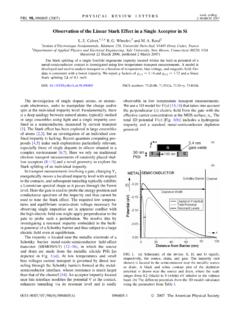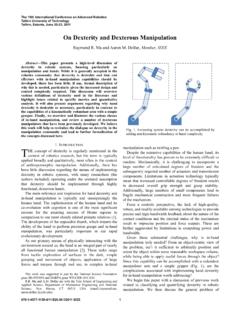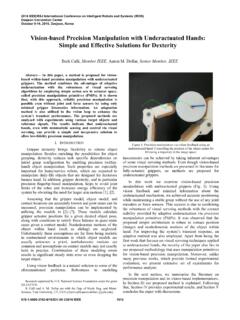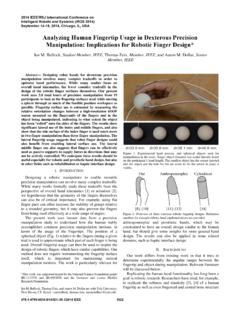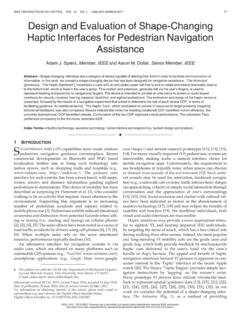Transcription of Onset of convection with fluid compressibility and ...
1 PHYSICS OF FLUIDS25,094105(2013) Onset of convection with fluid compressibilityand interface movementPhilip C. Myint1,2,a)and Abbas Firoozabadi1,3,b)1 Department of Chemical and Environmental Engineering, Yale University,9 HillhouseAvenue,NewHaven,Connecticut0651 1,USA2 Atmospheric, Earth, and Energy Division, Lawrence Livermore National Laboratory,Livermore, California 94550, USA3 Reservoir Engineering Research Institute, Palo Alto, California 94301, USA(Received 28 June 2013; accepted 5 September 2013; published online 25 September 2013)The density increase from carbon dioxide (CO2)dissolutioninwaterorhydrocar-bons creates buoyancy-driven instabilities that may lead to the Onset of convection is important for both CO2sequestration in deep saline aquifers andCO2improved oil recovery from hydrocarbon reservoirs.
2 We perform linear stabilityanalyses to study the effect of fluid compressibility and interface movement on theonset of buoyancy-driven convection in porous media. compressibility relates to anon-zero divergence of the velocity field. The interface between the CO2phase andthe aqueous or hydrocarbon phase moves with time as a result of the volume changethat occurs upon CO2dissolution. Previous stability analyses have neglected thesetwo aspects by assuming that the aqueous or hydrocarbon phase is incompressibleand that the interface remains fixed in position.
3 The stability analyses are used tocompute two key quantities: (1) the critical time and (2) the critical wavenumber. Ourresults indicate that compressibility has a negligible effect on the critical time and thecritical wavenumber in CO2-water mixtures. We use thermodynamics to derive anexpression which shows that the two opposing physical processes which contributeto the divergence are comparable in magnitude and largely cancel each other. Thisresult explains why compressibility does not significantly affect the Onset , and it alsodemonstrates the link between compressibility and the volume change that causesmovement of the interface .
4 Compared to when the interface is fixed in position, amoving interface in CO2-water mixtures may reduce the critical time by up to around10%, which can be significant in low permeability formations. The decrease in thecritical time due to interface movement may be much more pronounced in hydro-carbons than in water. This could have important implications for CO2improved 2013 AIP Publishing LLC.[ ]I. INTRODUCTIONG lobal energy demand from fossil fuels is expected to remain over 70% in the coming decades,despite considerable efforts to develop alternative energy of fossil fuelscontributes to rising atmospheric carbon dioxide (CO2)levelsthathavebeenlinkedtoclimatech ange.
5 Subsurface CO2injection can help society meet its high demand for fossil fuels and reduceatmospheric CO2levels. Carbon dioxide has been employed for over four decades in improved ,3 Dissolution of CO2in oil may reduce the viscosity by over an order of magnitude andmay increase the volume of the resulting mixture by up to 60%. The volume expansion helps to expelthe oil from smaller porous cavities. Within the past two decades, CO2injection for sequestration indeep saline aquifers has received considerable attention as a promising way to reduce atmospherica)Electronic 2013 AIP Publishing LLC25,094105-1 Downloaded 25 Sep 2013 to This article is copyrighted as indicated in the abstract.
6 Reuse of AIP content is subject to the terms at: C. Myint and A. FiroozabadiPhys. Fluids25,094105(2013) 6 This process involves capturing CO2emissions from stationary sources, such as powerplants, and storing the CO2by dissolving it in the aqueous phase that resides in the aquifers. The CO2is usually injected at supercritical conditions and forms a free phase because CO2is only partiallymiscible with thein situaqueous or hydrocarbon phase. We refer to the aqueous or hydrocarbonphase collectively as the liquid phase. The CO2phase is typically lighter than the liquid phase, andit initially mixes with the underlying liquid only by dioxide is the only common atmospheric gas that increases the density of hydrocarbonsupon dissolution,7and one of the few that increases the density of density increasecreates an unstable situation where heavier, CO2-dissolved fluid lies on top of lighter fluid.
7 Theinstabilities may lead to the Onset of buoyancy-driven convection in the liquid phase. convection isof great interest because it strongly enhances the CO2dissolution rate over diffusion alone. In thisway, it increases the efficiency of improved oil recovery processes. However, the convection may alsolead to earlier appearance of CO2in the production well, which is an undesirable consequence thatmust be monitored in field-scale ,10 convection not only increases the storage efficiencyof CO2sequestration, it also has implications for the long-term storage security of the dissolution of CO2into the aqueous phase reduces the pressure buildup in the free CO2phase.
8 The pressure reduction makes it less likely that the cap rock enclosing the aquifer will fracture,which lowers the risk of CO2leakage back into the atmosphere. Thus, convection is important forboth CO2improved recovery and CO2sequestration, and it is of interest to determine the conditionsunder which the instabilities may lead to the Onset of convection in the liquid authors have performed a linear stability analysis to theoretically predict the onsetof buoyancy-driven convection in the context of 16 Their work has been ex-tended to include features such as hydrodynamic dispersion,17temperature gradients,18,19chemicalreactions,20.
9 21and permeability 24 The state of the system before the Onset of con-vection, when CO2is transported through the liquid phase only by diffusion, is referred to as thebase state. The stability analysis is a semi-analytical method that introduces small wave-like pertur-bations to the base state in order to determine the conditions under which the base state becomesunstable. The stability analysis is used to calculate two key quantities: (1) the critical time and(2) the critical wavenumber. Onset of convection occurs at the critical time, which represents thefirst instance when the base state becomes unstable.
10 The critical wavenumber characterizes themost unstable perturbation mode. There have also been a number of numerical simulations25 29andlaboratory-scale experiments30 32regarding CO2sequestration. However, simulations and experi-ments focus on the time when the average CO2concentration in the liquid phase begins to deviatefrom the diffusion-only profile. This time may be quite distinct from the critical time and is an aspectof convection that is not examined by the stability analysis, which investigates only the Onset ,24,29 The aforementioned linear stability analyses have employed a common set of assumptions.
